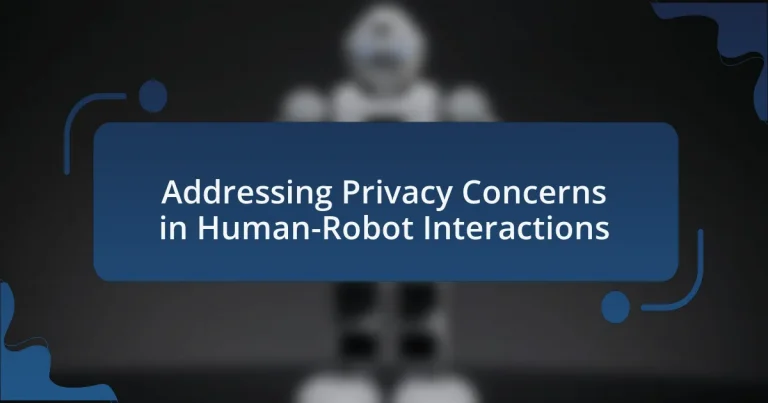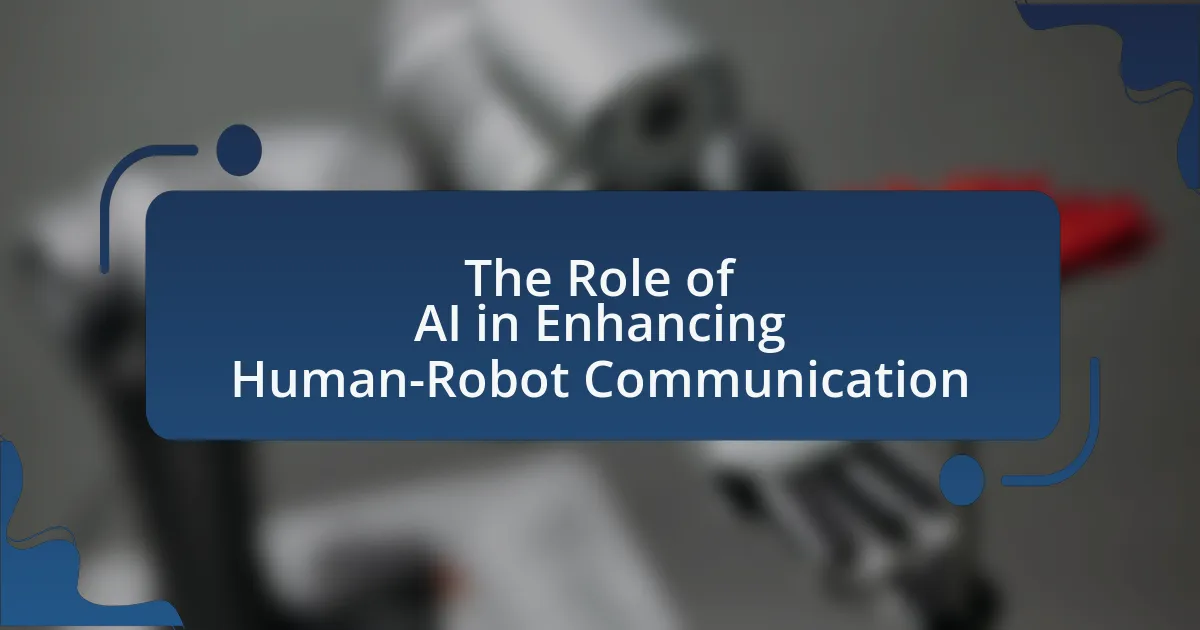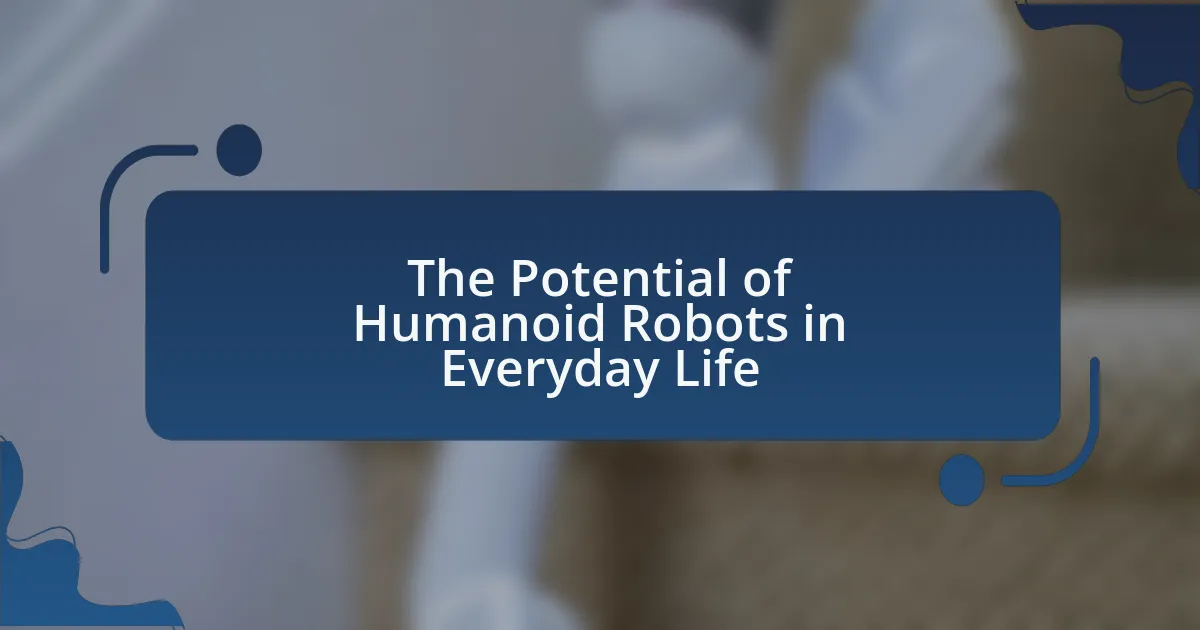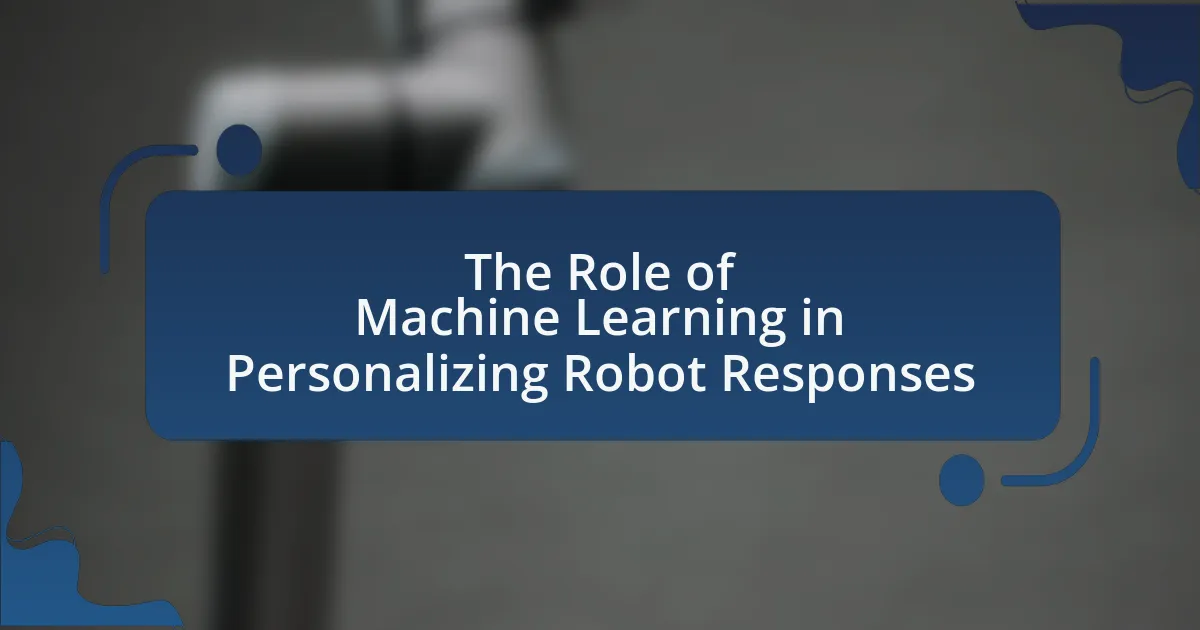The article focuses on addressing privacy concerns in human-robot interactions, highlighting key issues such as data collection, surveillance, and user consent. It examines how robots gather personal data through sensors and cameras, the types of data collected, and the importance of user consent in fostering trust. The article also discusses the implications of data breaches, the role of privacy regulations like GDPR, and best practices for compliance. Furthermore, it explores emerging technologies and innovations aimed at enhancing privacy protection, as well as practical steps users can take to safeguard their personal information during interactions with robots.
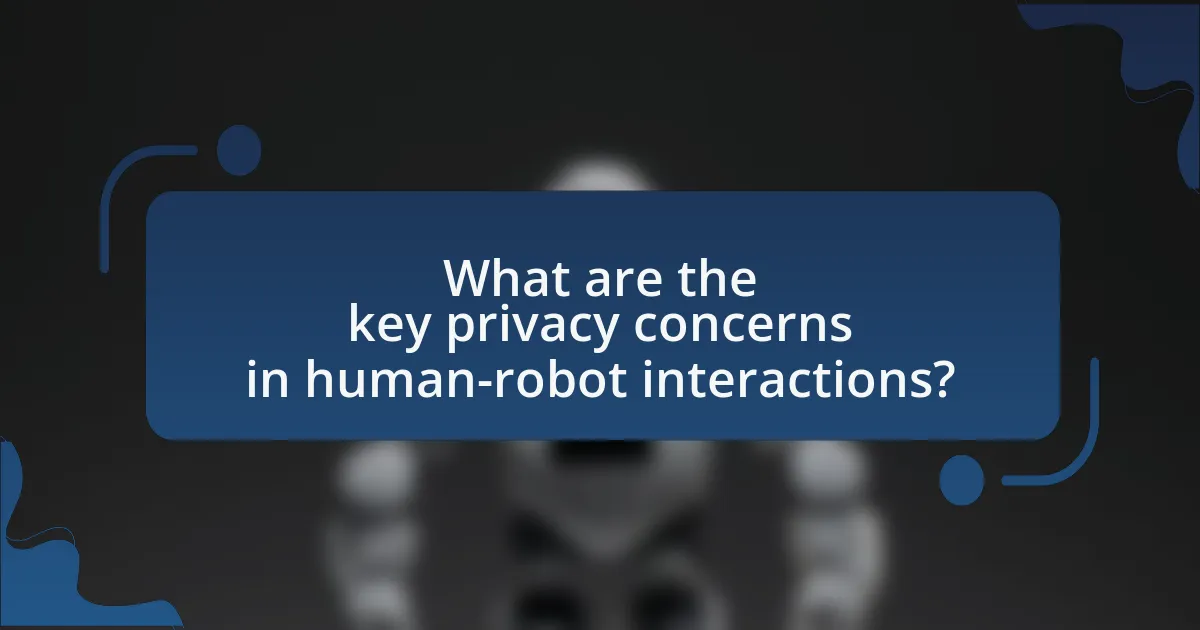
What are the key privacy concerns in human-robot interactions?
Key privacy concerns in human-robot interactions include data collection, surveillance, and user consent. Robots often gather personal information through sensors and cameras, raising issues about how this data is stored, used, and shared. For instance, a study by the University of Cambridge found that 70% of users are unaware of the extent of data collection by service robots, highlighting the need for transparency. Additionally, the potential for unauthorized surveillance poses risks, as robots may inadvertently record sensitive interactions. Lastly, the lack of clear consent mechanisms can lead to ethical dilemmas regarding user privacy rights.
How do robots collect personal data during interactions?
Robots collect personal data during interactions primarily through sensors and data processing algorithms. These technologies enable robots to capture information such as voice, facial expressions, and user behavior, which can be analyzed to understand user preferences and needs. For instance, robots equipped with cameras can recognize faces and track movements, while microphones can record conversations. This data is often stored and processed to improve the robot’s functionality and user experience, raising significant privacy concerns regarding consent and data security.
What types of personal data are commonly collected by robots?
Robots commonly collect various types of personal data, including biometric data, location data, interaction data, and user preferences. Biometric data may include fingerprints, facial recognition, or voice patterns, which are used for identification and authentication purposes. Location data is gathered through GPS or other tracking technologies to understand user movements and contexts. Interaction data encompasses the frequency and nature of user interactions with the robot, which helps in personalizing responses and improving user experience. User preferences are often collected to tailor services and functionalities according to individual needs. These data types raise significant privacy concerns, as they can be sensitive and are often subject to regulations like GDPR, which mandates transparency and user consent in data collection practices.
How is the collected data stored and processed?
Collected data in human-robot interactions is typically stored in secure databases and processed using advanced algorithms. These databases often employ encryption methods to protect sensitive information, ensuring that unauthorized access is prevented. Processing involves analyzing the data to improve robot functionality and user experience, often utilizing machine learning techniques to derive insights from user interactions. For instance, a study by K. Dautenhahn et al. (2018) highlights the importance of data anonymization and secure storage practices to mitigate privacy risks in robotic systems.
Why is user consent important in human-robot interactions?
User consent is crucial in human-robot interactions because it ensures that individuals have control over their personal data and the extent of their engagement with robotic systems. This control is essential for fostering trust between users and robots, as consent signifies that users are aware of and agree to the data collection and processing practices involved. Research indicates that when users feel their privacy is respected, they are more likely to engage positively with robotic technologies, enhancing user experience and acceptance. For instance, a study published in the journal “Robotics and Autonomous Systems” highlights that explicit consent mechanisms can significantly improve user satisfaction and willingness to interact with robots, thereby reinforcing the importance of consent in maintaining ethical standards in technology deployment.
What are the implications of lacking user consent?
Lacking user consent can lead to significant legal and ethical implications, including violations of privacy laws and loss of user trust. For instance, regulations such as the General Data Protection Regulation (GDPR) mandate that organizations obtain explicit consent before processing personal data. Failure to comply can result in hefty fines, with penalties reaching up to 4% of annual global turnover or €20 million, whichever is higher. Additionally, the absence of consent can damage the relationship between users and technology providers, leading to decreased user engagement and potential reputational harm.
How can robots ensure informed consent from users?
Robots can ensure informed consent from users by providing clear, accessible information about their functions, data usage, and potential risks before any interaction. This involves using straightforward language and visual aids to explain how user data will be collected, stored, and utilized, allowing users to make an educated decision regarding their participation. Research indicates that transparency in communication significantly enhances user trust and understanding, which is crucial for informed consent in technology interactions. For instance, a study published in the Journal of Human-Robot Interaction highlights that users are more likely to consent when they feel adequately informed about the implications of their engagement with robots.
What are the potential risks of data breaches in human-robot interactions?
Data breaches in human-robot interactions pose significant risks, including unauthorized access to sensitive personal information, manipulation of robotic behavior, and erosion of trust between humans and robots. Unauthorized access can lead to the exposure of private data, such as health records or personal preferences, which can be exploited for malicious purposes. Manipulation of robotic behavior can result in robots acting in ways that compromise safety or security, as seen in incidents where hackers have taken control of connected devices. Furthermore, the erosion of trust can hinder the adoption of robotic technologies, as users may fear that their data is not secure, impacting the overall effectiveness of human-robot collaboration. These risks highlight the critical need for robust security measures in the design and deployment of robotic systems.
What are the consequences of a data breach for users?
A data breach can lead to significant consequences for users, including identity theft, financial loss, and compromised personal information. Users may experience unauthorized access to their accounts, resulting in fraudulent transactions or misuse of sensitive data. According to a 2020 report by the Identity Theft Resource Center, over 1.1 million individuals were affected by identity theft due to data breaches, highlighting the widespread impact. Additionally, users may face emotional distress and a loss of trust in the organizations that failed to protect their data, which can have long-term implications for customer relationships and brand reputation.
How can robots mitigate the risks of data breaches?
Robots can mitigate the risks of data breaches by implementing advanced encryption protocols and secure data handling practices. These technologies ensure that sensitive information is protected during transmission and storage, reducing the likelihood of unauthorized access. For instance, robots equipped with end-to-end encryption can safeguard user data, making it unreadable to potential attackers. Additionally, regular software updates and vulnerability assessments can help identify and rectify security weaknesses, further enhancing data protection. According to a study by the National Institute of Standards and Technology, employing robust encryption methods can significantly lower the risk of data breaches in automated systems.
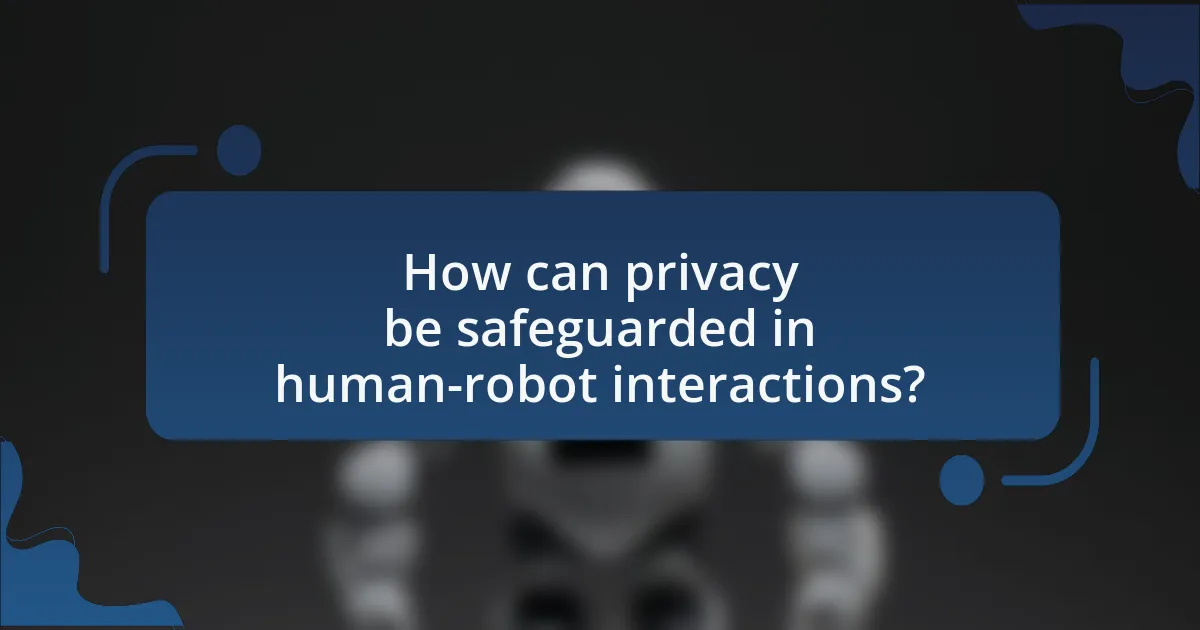
How can privacy be safeguarded in human-robot interactions?
Privacy can be safeguarded in human-robot interactions through data minimization, encryption, and user consent protocols. Data minimization involves collecting only the necessary information required for the robot’s functionality, thereby reducing the risk of sensitive data exposure. Encryption protects data during transmission and storage, ensuring that unauthorized access is prevented. User consent protocols empower individuals by allowing them to control what data is collected and how it is used, fostering transparency and trust. These measures are supported by regulations such as the General Data Protection Regulation (GDPR), which emphasizes the importance of privacy in technology.
What privacy regulations apply to human-robot interactions?
Privacy regulations that apply to human-robot interactions include the General Data Protection Regulation (GDPR) in the European Union, which mandates strict guidelines on data collection, processing, and storage, particularly concerning personal data. Additionally, the California Consumer Privacy Act (CCPA) in the United States provides consumers with rights regarding their personal information, including the right to know what data is collected and the right to delete it. These regulations are crucial as they establish legal frameworks that govern how robots, which often collect and process personal data, must operate to protect individuals’ privacy rights.
How do these regulations impact robot design and functionality?
Regulations addressing privacy concerns significantly impact robot design and functionality by mandating compliance with data protection standards. These regulations require robots to incorporate features such as data encryption, user consent mechanisms, and transparent data handling practices to ensure user privacy. For instance, the General Data Protection Regulation (GDPR) in the European Union enforces strict guidelines on how personal data is collected, stored, and processed, compelling robot manufacturers to design systems that prioritize user consent and data minimization. Consequently, robots must be equipped with functionalities that allow users to control their data, such as opting out of data collection or accessing their information, thereby influencing both the technical specifications and user interface design of robotic systems.
What are the best practices for compliance with privacy regulations?
The best practices for compliance with privacy regulations include conducting regular privacy impact assessments, implementing data minimization principles, ensuring transparency in data collection, and providing robust data security measures. Regular privacy impact assessments help organizations identify and mitigate risks associated with personal data processing, as recommended by the General Data Protection Regulation (GDPR). Data minimization principles dictate that only necessary data should be collected, reducing exposure to potential breaches. Transparency in data collection involves informing individuals about how their data will be used, which is a requirement under various privacy laws. Finally, robust data security measures, such as encryption and access controls, are essential to protect personal data from unauthorized access, aligning with best practices outlined by the National Institute of Standards and Technology (NIST).
How can technology enhance privacy in human-robot interactions?
Technology can enhance privacy in human-robot interactions by implementing advanced encryption methods and data anonymization techniques. These technologies ensure that personal data collected during interactions is securely encrypted, making it inaccessible to unauthorized users. For instance, end-to-end encryption can protect communication between humans and robots, while anonymization techniques can strip identifiable information from data sets, thereby safeguarding user identities. Research indicates that employing such measures can significantly reduce the risk of data breaches and unauthorized surveillance, thereby fostering trust in robotic systems.
What role does encryption play in protecting user data?
Encryption plays a critical role in protecting user data by converting it into a secure format that is unreadable without the appropriate decryption key. This process ensures that even if data is intercepted during transmission or accessed without authorization, it remains confidential and secure from unauthorized users. For instance, the use of Advanced Encryption Standard (AES) is widely recognized for its effectiveness in safeguarding sensitive information, as it employs complex algorithms that make unauthorized access extremely difficult. Consequently, encryption not only protects personal information but also builds trust in systems that handle user data, particularly in contexts like human-robot interactions where privacy concerns are paramount.
How can anonymization techniques be applied in robot data handling?
Anonymization techniques can be applied in robot data handling by removing or obfuscating personally identifiable information (PII) from the data collected during human-robot interactions. This process ensures that data such as names, addresses, and other identifiers are either masked or replaced with pseudonyms, thereby protecting individual privacy. For instance, a study published in the Journal of Robotics and Autonomous Systems demonstrates that implementing data anonymization protocols can significantly reduce the risk of privacy breaches while maintaining the utility of the data for analysis and improvement of robotic systems.
What ethical considerations should be taken into account?
Ethical considerations in addressing privacy concerns in human-robot interactions include informed consent, data security, and user autonomy. Informed consent requires that users are fully aware of how their data will be collected, used, and shared by robots, ensuring transparency in interactions. Data security is crucial, as robots often collect sensitive personal information; thus, robust measures must be implemented to protect this data from unauthorized access or breaches. User autonomy emphasizes the importance of allowing individuals to control their interactions with robots, including the ability to opt-out of data collection. These considerations are supported by guidelines from organizations such as the IEEE, which advocate for ethical standards in technology development and deployment.
How can ethical frameworks guide the development of privacy-conscious robots?
Ethical frameworks can guide the development of privacy-conscious robots by establishing principles that prioritize user consent, data minimization, and transparency. These frameworks, such as the IEEE Global Initiative on Ethics of Autonomous and Intelligent Systems, emphasize the importance of respecting individual privacy rights and ensuring that robots are designed to operate within ethical boundaries. For instance, the principle of data minimization advocates for collecting only the necessary information to perform a task, thereby reducing the risk of privacy breaches. Additionally, transparency in how data is collected and used fosters trust between users and robots, aligning with ethical standards that promote accountability.
What are the responsibilities of developers in ensuring user privacy?
Developers are responsible for implementing robust data protection measures to ensure user privacy. This includes designing systems that minimize data collection, employing encryption for sensitive information, and ensuring compliance with privacy regulations such as GDPR. For instance, developers must conduct regular security audits and vulnerability assessments to identify and mitigate risks to user data. Additionally, they should provide clear privacy policies that inform users about data usage and obtain informed consent before data collection. These practices are essential to build trust and protect users in the context of human-robot interactions.
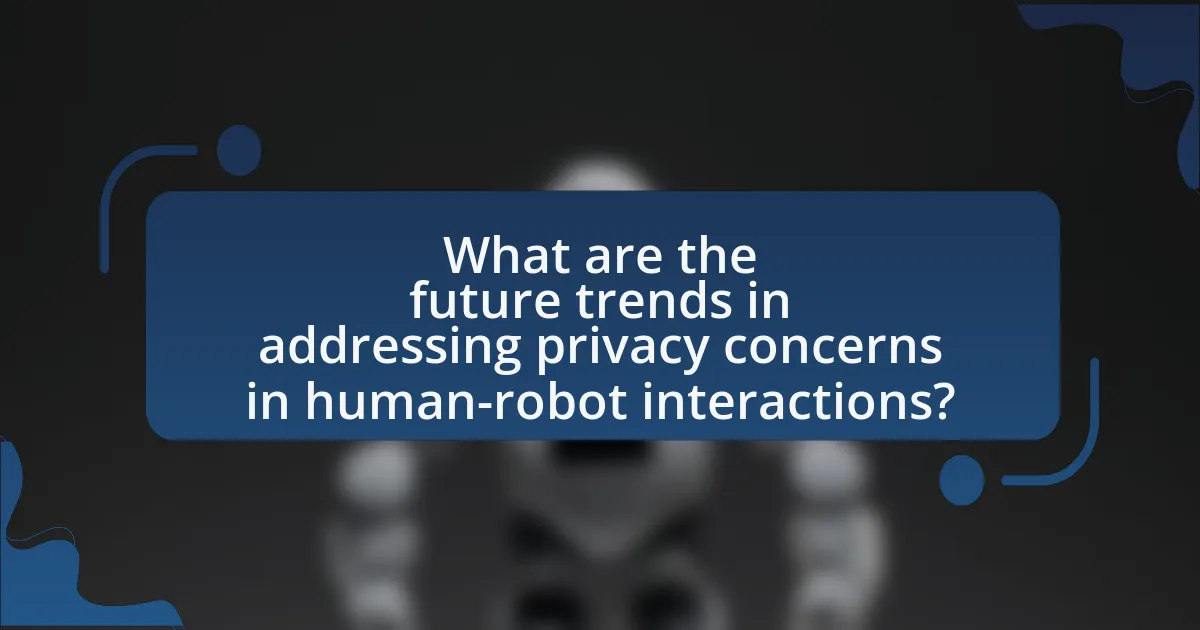
What are the future trends in addressing privacy concerns in human-robot interactions?
Future trends in addressing privacy concerns in human-robot interactions include enhanced data encryption, user consent frameworks, and the implementation of ethical AI guidelines. Enhanced data encryption will protect sensitive information collected by robots, ensuring that personal data remains secure from unauthorized access. User consent frameworks will empower individuals to control how their data is used, fostering transparency and trust in robotic systems. Additionally, the implementation of ethical AI guidelines will promote responsible design and deployment of robots, ensuring that privacy considerations are integrated into the development process. These trends are supported by ongoing research in privacy-preserving technologies and regulatory developments aimed at safeguarding user data in automated environments.
How is public perception of privacy in robotics evolving?
Public perception of privacy in robotics is increasingly concerned about data security and surveillance implications. As robots become more integrated into daily life, individuals express heightened awareness of how personal data is collected, stored, and used. A 2021 survey by the Pew Research Center found that 72% of Americans are worried about the potential misuse of personal information by robots and AI systems. This growing apprehension reflects a shift towards demanding greater transparency and control over personal data in robotic applications, indicating that public sentiment is evolving towards a more cautious and protective stance regarding privacy.
What factors influence user trust in robots regarding privacy?
User trust in robots regarding privacy is influenced by factors such as transparency, data security, user control, and perceived reliability. Transparency involves clear communication about how data is collected, used, and stored, which fosters trust. Data security measures, including encryption and secure storage, are critical in assuring users that their information is protected from unauthorized access. User control allows individuals to manage their privacy settings and decide what data to share, enhancing their sense of agency and trust. Lastly, perceived reliability, which encompasses the robot’s performance consistency and adherence to privacy protocols, significantly impacts user confidence. Research indicates that these factors collectively shape user perceptions and trust levels in robotic systems, as highlighted in studies on human-robot interaction dynamics.
How can user feedback shape future privacy practices in robotics?
User feedback can significantly shape future privacy practices in robotics by providing insights into user concerns and preferences regarding data handling. This feedback allows developers to identify specific privacy issues, such as data collection methods and user consent processes, which can lead to the implementation of more transparent and user-centric privacy policies. For instance, a study by the University of Cambridge found that incorporating user feedback into the design of robotic systems resulted in enhanced trust and satisfaction, highlighting the importance of addressing user privacy concerns directly. By actively engaging users in the development process, robotics companies can create systems that not only comply with regulations but also align with user expectations, ultimately fostering a safer and more ethical interaction environment.
What innovations are being developed to enhance privacy in robotics?
Innovations being developed to enhance privacy in robotics include advanced data anonymization techniques, secure multi-party computation, and federated learning. Data anonymization techniques ensure that personal information collected by robots is stripped of identifiable details, thereby protecting user privacy. Secure multi-party computation allows robots to process data without exposing sensitive information to other parties, enhancing confidentiality during data sharing. Federated learning enables robots to learn from decentralized data sources without transferring raw data to a central server, thus maintaining user privacy while improving machine learning models. These innovations are crucial as they address the growing concerns regarding data security and privacy in human-robot interactions.
How can artificial intelligence improve privacy measures in robots?
Artificial intelligence can improve privacy measures in robots by implementing advanced data encryption and anonymization techniques. These techniques ensure that sensitive information collected during human-robot interactions is securely stored and processed, minimizing the risk of unauthorized access. For instance, AI algorithms can analyze data patterns to identify personally identifiable information and automatically anonymize it before storage, thereby protecting user privacy. Additionally, AI can enable real-time monitoring of data access and usage, ensuring compliance with privacy regulations such as GDPR. This proactive approach to data management not only enhances user trust but also aligns with legal standards, demonstrating the effectiveness of AI in safeguarding privacy in robotic systems.
What emerging technologies are promising for privacy protection in human-robot interactions?
Emerging technologies promising for privacy protection in human-robot interactions include advanced encryption methods, federated learning, and differential privacy techniques. Advanced encryption ensures that data transmitted between humans and robots is secure, preventing unauthorized access. Federated learning allows robots to learn from user interactions without transferring sensitive data to central servers, thereby maintaining user privacy. Differential privacy techniques add noise to data, ensuring that individual user information cannot be easily extracted while still allowing for useful insights. These technologies collectively enhance privacy by safeguarding personal information in human-robot interactions.
What practical steps can users take to protect their privacy when interacting with robots?
Users can protect their privacy when interacting with robots by limiting the personal information they share. This includes avoiding the disclosure of sensitive data such as full names, addresses, and financial information during interactions. Additionally, users should review the privacy settings of the robot and any associated applications to ensure data sharing is minimized. Research indicates that many robots collect data for functionality, so understanding the data retention policies of the manufacturer can help users make informed decisions about their interactions. Furthermore, users should consider using anonymization techniques, such as creating pseudonyms or using temporary accounts, to further safeguard their identity.
